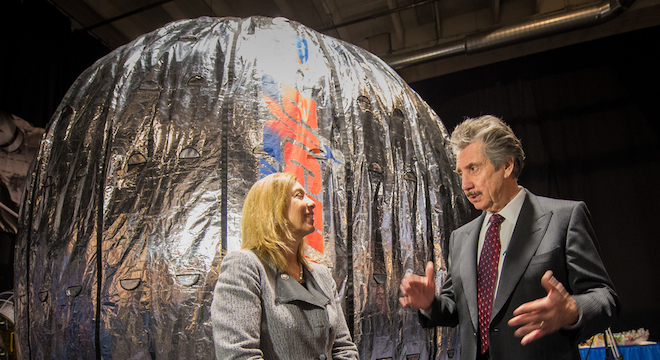Bigelow Aerospace, the private spacefaring company that NASA is paying to develop and launch an inflatable space module to the International Space Station in 2015, already has plans on how it will separately commercialize the balloon-like craft for its own space operations.
“We have motivations as a company to see the BEAM project be successful outside of the NASA mission,” said Robert T. Bigelow, creator of his namesake commercial space company, which he started from his fortune accumulated as the owner of the Budget chain of hotels, in a phone interview on Thursday.
NASA’s plans call for the inflatable test module, known as the Bigelow Expandable Activity Module (BEAM), to remain connected to the station for two years — with astronauts entering and leaving as deemed fit — then detached and destroyed, burned up in Earth’s atmosphere.
But Bigelow, the company and the man, intend to produce another BEAM habitat that could be attached to a planned Bigelow-owned and built private space station, for use by space tourists and non-spacefaring governments. The first component of that station, a larger inflatable module known as the BA 330, could launch as early as 2016.
The goal is to then use the smaller attached balloon-like BEAM to function as the world’s most spacious airlock, allowing for up to three space tourists to simultaneously spacewalk outside the station simultaneously.
“BEAM would be excellent for EVA [extra-vehicular activity],” Bigelow told TPM, referring to the technical term for activities conducted by humans outside of space craft and habitations like BEAM. “You could accomodate three people in space suits in there very easily. From a practical standpoint, you’d be able to move more people outside of the station at once to do whatever it is they need to do.
In recent years, when repairs to the outside of the International Space Station must be completed by its human crew, NASA usually sends out two astronauts at once. But the rigid “Quest” airlock aboard the International Space Station can only accomodate two astronauts at a time during its depressurization phase, necessary before opening into outer space.
Bigelow’s plan is to inflate the BEAM module to a larger size than the current space station’s airlock, enough to accomodate three people at once.
Bigelow, the man, told TPM that a collapsable airlock could afford several other advantages over its rigid metal counterparts currently in use on spacecraft and the International Space Station. Not having an airlock sticking out of the craft at certain times could make repairs easier, would allow for solar arrays and other equipment to be moved around with greater ease and efficiency, and, perhaps most importantly, would allow for less nitrogen and oxygen to escape into the vacuum of outer space — which happens every time a current airlock door is opened.
“You lose that gas every time you open the outer hatch,” Bigelow explained to TPM.
Bigelow’s BEAM airlock concept would still necessarily allow some of these gases to escape, of course, as soon as the airlock door was opened to outer space. But because the BEAM could be inflated to a larger working volume than the current space station’s airlock, more spacewalkers could be sent in and out simultaneously, necessitating less opening and closing of the door.
Bigelow told TPM that currently, his company is leaning toward allowing its first few bunch of paying space tourists or government astronauts the ability to spacewalk as a bonus atop the cost of the tickets up to the private space station. The starting price is $26.25 million for a two-month long stay, with transportation provided by SpaceX’s Dragon capsule.
Spacewalks have advanced along with the rest of human spaceflight capability since the Cold War and the first-ever spacewalk by Soviet cosmonaut Alexei Leonov during the Voskhod 2 orbital mission, as The Atlantic‘s following video montage compiled of NASA archival footage shows. But Bigelow’s plans, if fulfilled, would mark the first private spacewalks in human history.









